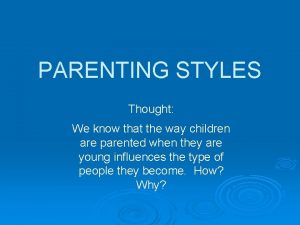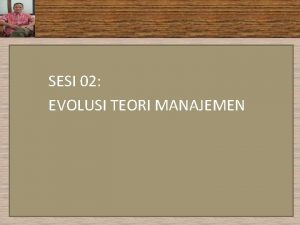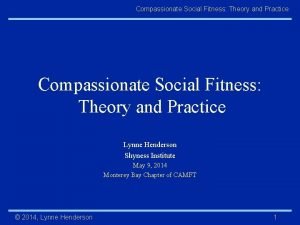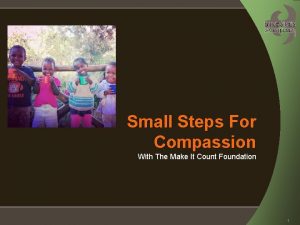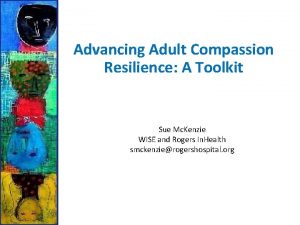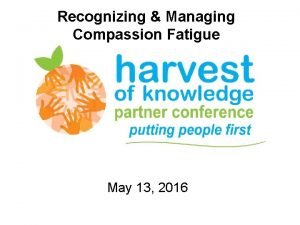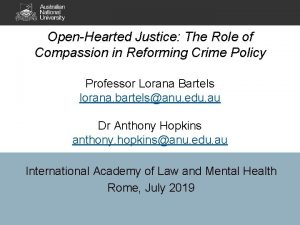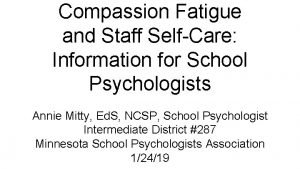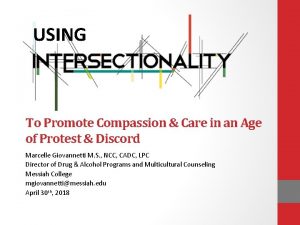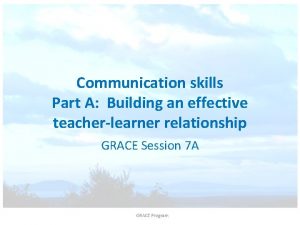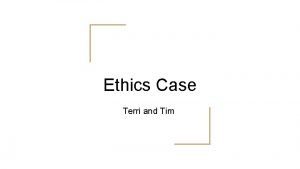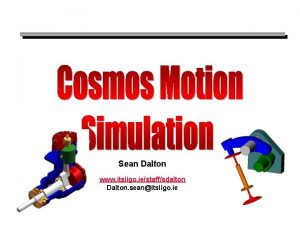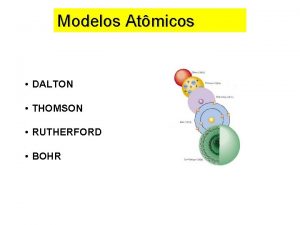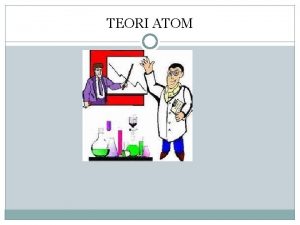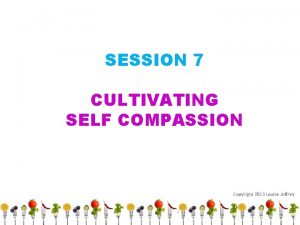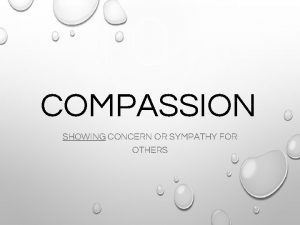Cultivating Compassion Through the TeacherLearner Relationship Terri Dalton
























- Slides: 24

Cultivating Compassion Through the Teacher-Learner Relationship Terri Dalton, MA, Cleveland Clinic/Fairview FMR, Cleveland, OH Kathryn Fraser, Ph. D, Halifax Health FMR, Daytona Beach. FL Janelle Von Bargen, Ph. D, St. Francis Hospital FMR, Wilmington, DE Dael Waxman, MD, Carolinas Medical Center FMR, Charlotte, NC

No Disclosures

Objectives Upon completion of this session, you should be able to: • Define the concept of hidden mentorship and its importance in the arena of compassionate care • Describe the parallel process of the teacherlearner and the learner-patient present in medical education • Design a personal plan for compassionate care that actively integrates parallel process and hidden mentorship

Personal and Professional Satisfaction in Medicine Matters

We replicate the experience we are given.

The Process is A Win-Win It is as much about the teacher. It is as much about the learner. It is as much about the patient.

Peeking into the Preceptor Room

Auto-Pilot: Getting the Job Done vs. Dropping In: Being Fully Present

Hidden Mentorship defined as We replicate with our patients the very experience we are given – teacher to learner, learner to patient, learner to teacher/peer. An infinite cycle of good that gets replicated.

Parallel Process defined as • Awareness of your own issues/dynamics that may be similar to your patient or learner. • Self-reflections can help you avoid getting drawn into a spin by being attentive to parallel process. It is a teacher, a guide and a mentor. Michael J Formica MS, MA, Ed. M Enlightened Living The Me in You: Parallel Process in Psychotherapy When the client is the mirror.

. Dropping-In defined as • Awareness of two aspects of your moment-tomoment experience: Ø what’s going on around you and Ø what’s going on within you. • From mindfulness literature: to be consciously present in what you’re doing, while you’re doing it, as well as managing your mental and emotional state. http: //greatschoolspartnership. org/wp-content/uploads/2016/11/10 -Ways-to-Be-More-Mindful-at-Work. pdf

Compassionate Care defined as • experiencing empathy • and wanting to do something about it

Narrative Medicine Informs Compassionate Care • …it may be that the physician’s most potent therapeutic instrument is the self, which is attuned to the patient through engagement, on the side of the patient through compassion, and available to the patient through reflection. Narrative Medicine – Charon

TIME FOR FREE- WHEELING • RECALL: Take 5 -minutes to remember a time when you have had a teacher-learner interaction that you felt worked, that you felt you “dropped-in” with the learner. • WRITE: Self-Reflection • What qualities did you bring that made the interaction effective?

PAIR – SHARE • PAIR: Gather in dyads & share your recalled situation, first one person listens deeply and then trade when we announce it is time to switch • SHARE: Listen mindfully to your colleague’s story and ask them • What qualities did you bring to the interaction they shared? • What unique things could you describe that helped you to get there?

Self-Reflection defined as • Take time apart from a situation to look back on emotional and spiritual reactions within yourself Ø Assess how it connects with events in your past Ø Imagine how will it affect your future responses • How does dropping-in shift gears and change the dynamic?

Mindfulness Informs Compassionate Care • By enabling physicians to be more attentive to patients and their needs, a mindful orientation holds promise for making clinical encounters more patient centered and for enhancing patient-clinician communication. Multicenter Study of Physician Mindfulness -- Beach, Roter, Korthius,

Mindfulness Informs Compassionate Care • Epstein writes of mindful practice: “This critical self-reflection enables physicians to listen attentively to patients’ distress, recognized their own errors, refine their technical skills, make evidence-based decisions, and clarify their values so they can act with compassion, technical competence, presence, and insight. ” Multicenter Study of Physician Mindfulness -- Beach, Roter, Korthius,

Is there an Elephant in the Room?

What are the barriers? What are the benefits?

Group’s Processing During Seminar

It begins with intentionality. Plan one thing you can do to drop -in and cultivate compassion with your learners?

We thank you for Please evaluate thisus presentation using the joining today! conference mobile app! Simply click on the "clipboard" icon on the presentation page.

References Charon R MD, Ph. D. JAMA. 2001; 286(15): 1897 -1902. doi: 10. 1001/jama. 286. 15. 1897. Narrative medicine a model for empathy, reflection, profession, and trust. Epstein RM, Street Jr RL. Ann Fam Med March/April 2011 vol. 9 no. 2 100 -103. doi: 10. 1370/afm. 1239. The values and value of patient-centered care. Beach MC 1, Roter D, Korthuis PT, Epstein RM, Sharp V, Ratanawongsa N, Cohn J, Eggly S, Sankar A, Moore RD, Saha S. Ann Fam Med. 2013 Sep-Oct; 11(5): 421 -8. doi: 10. 1370/afm. 1507. A multicenter study of physician mindfulness and health care quality. Krasner MS 1, Epstein RM, Beckman H, Suchman AL, Chapman B, Mooney CJ, Quill TE. JAMA. 2009 Sep 23; 302(12): 1284 -93. doi: 10. 1001/jama. 2009. 1384. Association of an educational program in mindful communication with burnout, empathy, and attitudes among primary care physicians. Michael J Formica MS, MA, Ed. M, Enlightened Living, The Me in You: Parallel Process in Psychotherapy When the client is the mirror. A Conceptual Framework for the Use of Illness Narratives in Medical Education Arno K. Kumagai, MD 658 Academic Medicine, Vol. 83, No. 7 / July 2008 An Appreciative Inquiry Approach to Practice Improvement and Transformative Change in Health Care Settings Caroline A. Carter, BA, LSW; Mary C. Ruhe, BS, RN; Sharon Weyer, DNP, RN, NP-C; David Litaker, MD, Ph. D; Ronald E. Fry, Ph. D; Kurt C. Stange, MD, Ph. D Q Manage Health Care Vol. 16, No. 3, pp. 194– 204 c 2007 Wolters Kluwer Health | Lippincott Williams & Wilkins
 Terri hopkins
Terri hopkins Joseph kallinger
Joseph kallinger Le terri
Le terri Michelle thompson wife swap
Michelle thompson wife swap Ready set kindergarten pinellas county
Ready set kindergarten pinellas county Terri mcnamara
Terri mcnamara Terri schiavo eset
Terri schiavo eset Spokesperson
Spokesperson Terri seddon
Terri seddon Compassion theory
Compassion theory Since
Since Small steps for compassion
Small steps for compassion Everyone needs compassion
Everyone needs compassion Compassion focused therapy
Compassion focused therapy Peter stevenson compassion in world farming
Peter stevenson compassion in world farming Project compassion 2016
Project compassion 2016 Compassion resilience toolkit
Compassion resilience toolkit Benefits of self compassion
Benefits of self compassion What is compassion fatigue
What is compassion fatigue Lorana bartels
Lorana bartels Compassion fatigue handout for teachers
Compassion fatigue handout for teachers Too much compassion
Too much compassion Compassion care counseling
Compassion care counseling There is no jew nor greek
There is no jew nor greek Compassion fatigue signs
Compassion fatigue signs



